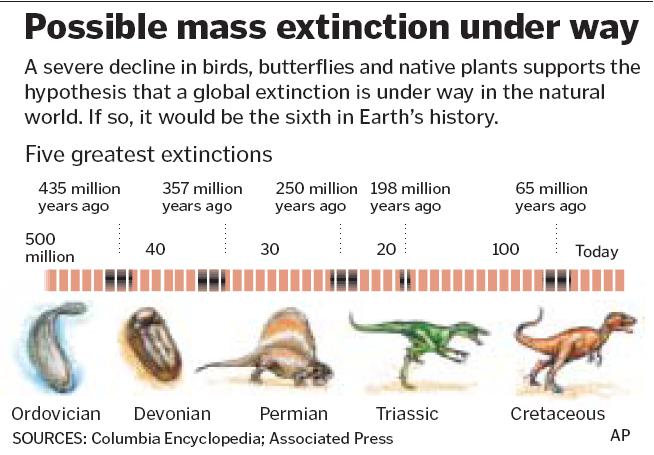Link:
http://story.news.ya...ountains_report
http://us.news2.yimg...1888a398967860dReport Shows Smokies 'Beginning to Die' Thu Apr 15, 7:11 AM ET Add Science - AP to My Yahoo!
GATLINBURG, Tenn. - A new report by the National Parks Conservation Association on the future of the Great Smoky Mountains National Park paints a dire picture.
"This park is beginning to die," said Tom Kiernan, the conservation group's president. "This assessment clearly shows the park is in danger, and its long-term viability is at risk."
High ozone levels, acid rain, continued underfunding and a proposed road on the north shore of Fontana Lake in North Carolina are combining to endanger the park's future, Kiernan said.
Much of the damage could be slowed or prevented if certain steps are taken, he said, including rigorous enforcement of the federal Clean Air Act and increasing the park's budget.
"The question is will our society and Congress step up to implement these recommendations," Kiernan said.
If the Smokies aren't protected, the negative impact on the region's economy and quality of life could be significant, he said.
"This is the first health assessment of the park, and it's not good," Kiernan said. "It's worrisome."
There had been no previous systemic, park-wide scientific study to provide a benchmark for future recommendations for the Smokies before Wednesday's report, Kiernan said. The public was forced to rely on conflicting findings of various groups, scientists and organizations when trying to evaluate the park's ecosystem, he said.
Raw data for the report was combined from the National Park Service, the U.S. Environmental Protection Agency (news - web sites) and various state agencies to gather all data that is published or unpublished on parks, Kiernan said.
"This has significant scientific credibility in the United States and is gaining it worldwide," he said.
Several areas of concern were noted in the report on the Smokies. Among them are:
_ Ground level ozone and acid rain "threaten the health of park visitors, staff, vegetation, soils and streams."
_ Air pollution has diminished visibility from an average of 113 miles from prime viewing locations to an average of 25 miles.
_ The park has an annual budget shortfall of more than $11 million, and needs another 108 new full-time positions to adequately protect resources.
_ Nonnative pests and diseases are killing off Fraser firs, hemlocks, dogwoods, butternuts and beech trees.
Much of the air pollution in the Smokies is from the burning of fossil fuels, particularly those used in power plants, factories and automobiles, officials said.
Conservation association program analyst Jill Stephens and Sandy McLaughlin, a researcher at the Oak Ridge National Laboratory and the University of Tennessee, described the scope of the park's air-pollution problem Wednesday while at the Twin Creeks research station.
At the research station, one of three in the Smokies and Oak Ridge, 35 trees are constantly monitored by devices that check their growth, sap flow and other vital signs every half-hour, they said.
While pollutants affect vegetation throughout the park, trees that grow at higher elevations — such as spruce and firs trees — are hit especially hard, Stephens said. Also, rainfall is up to 10 times as acidic as normal precipitation in the park and fog is often 100 times more acidic, McLaughlin said.
Jim Renfro, a Park Service air-resource specialist, said that some species of plants are showing "visible leaf damage" from the pollution, while others aren't growing as well. He also noted that during the past 15 years the park has had more than 300 "bad-air days," meaning ozone levels were high enough to threaten public health.
"That's way too many," he said. "There shouldn't be any in a national park."
Experts expect the Smokies to be designated a "non-attainment" area Thursday when the EPA releases its list of areas that haven't met federal clean-air standards meant to protect public health.
Officials of the parks conservation group also are opposed to the proposed North Shore Road project, also known as the "Road to Nowhere," in Swain County, N.C. The road was started in the early 1960s, but work ended because of cost and environmental problems.
The issue appeared again in 2000 when North Carolina Rep. Charles Taylor and Sen. Jesse Helms tacked a new $16 million appropriation for the road onto a transportation bill. The conservation group contends completing the road would be costly and also inflict serious environmental damage to the park.
___
On the Net:
Great Smoky Mountains National Park:
http://www.nps.gov/grsm/ National Parks Conservation Association:
http://www.npca.org/



























































